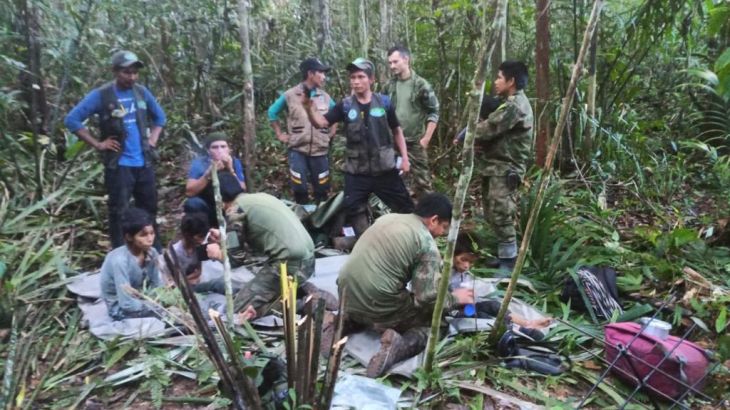Colombia plane crash: Children survived 40 days eating seeds
Four children were discovered by a team of army and Indigenous people after their plane crashed in the Amazon jungle on May 1.

Four Colombian Indigenous children, who were discovered 40 days after their plane crashed in the Amazon jungle, survived eating seeds, roots and plants they knew were edible thanks to their upbringing, according to Indigenous people.
“The survival of the children is a sign of the knowledge and relationship with the natural environment that is taught starting in the mother’s womb,” according to the National Organization of Indigenous Peoples of Colombia (OPIAC).
Keep reading
list of 3 itemsWiretapping scandal thrusts Colombian government into crisis
Colombian gang leaders announce talks to address urban violence
The local knowledge of Indigenous adults, who were involved in the search alongside Colombian troops, also played a part in the children being found alive.
The four siblings, aged 13, nine and four, as well as a now 12-month-old baby, survived a small plane crash on May 1 that took the lives of the pilot, their mother and a third adult. The children’s family clung to the hope that the siblings’ familiarity with the jungle would see them through.
“They are Indigenous children and they know the jungle well. They know what to eat and what not to eat. They survived because of this and their spiritual force,” said Luis Acosta of the National Indigenous Organization of Colombia (ONIC).
Acosta, who took part in search operations, said the children ate seeds, fruits, roots and plants they identified as edible from their upbringing in the Amazon region.
The children have been reunited with their family after their rescue on Friday.
“They are happy to see the family… they have all their senses,” the children’s grandfather, Fidencio Valencia, told reporters shortly after visiting them at a military hospital in the capital Bogota.
“They are children of the bush,” Valencia said, adding that they know how to survive in the jungle.
Javier Betancourt, another ONIC leader, told AFP: “We have a particular connection to nature.”
“The world needs this kind of special relation with nature, to favour those like the Indigenous who live in the jungle and take care of it.”
‘Operation Hope’
During the search, soldiers worked side by side with Indigenous trackers for 20 days.
Army chief Helder Giraldo said rescuers had covered over 2,600 kilometers (1,650 miles) in total to locate the children. “Something that seemed impossible was achieved,” Giraldo said on Twitter.
President Gustavo Petro praised what he called a “meeting of Indigenous and military knowledge” that he said showed respect for the jungle.
Army helicopters broadcast recordings of the children’s grandmother telling them in the Indigenous Huitoto language to stay put in one spot until rescuers reached them.
“It was President Petro who brought us together,” Acosta told local media, referring to soldiers and Indigenous experts.
“In an initial meeting, eight days before our search began, the president told us we needed to go with the army because the army couldn’t do it alone,” he added.
More than 80 volunteers from Indigenous territories in the departments of Caqueta, Putumayo, Meta and Amazonas joined around 100 soldiers in what was dubbed “Operation Hope”.
It was an unusual union of forces.
In many of Colombia’s Indigenous territories, armed outlaw groups roam and easily coerce native peoples, who protect their lands with rudimentary weapons. Relations between Indigenous communities and the armed forces are also strained.
But in the Guaviare department, rescuers from separate groups set their differences aside to work together.
While soldiers planned operational details, native searchers held rituals to communicate with jungle “spirits,” using mambe, a paste made of coca leaf and ash, as well as chirrinchi, a fermented drink.
Using machetes, rescuers felled trees and marked them with spray paint to guide the children.
Indigenous medicinal knowledge was also used to adapt to the difficult jungle conditions, treating scratches, splinters, insect bites, exhaustion and physical pain.
The Indigenous people have “worked in the rain, in storms and in many difficult situations, but always with the hope and spiritual faith that [the children] could be found,” Acosta said.
It all led to the discovery of the siblings by an Indigenous tracker in an area that had not yet been explored.